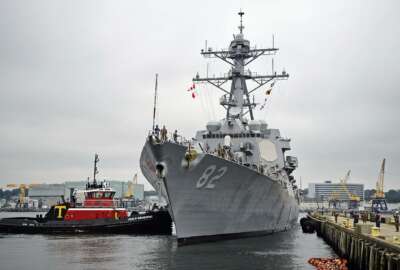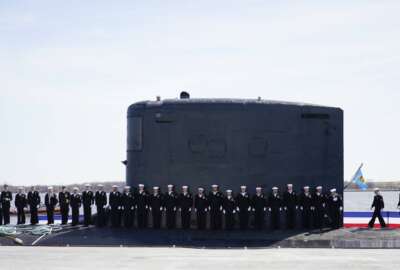
Navy shipbuilding has an uncertain future…and budget
The Navy is not quite certain how many ships and submarines it wants to build over the next few decades. In fact, it has offered three alternative plans to...
The Navy is not quite certain how many ships and submarines it wants to build over the next few decades. In fact, it has offered three alternative plans to Congress, with varying timelines and price tags. For analysis, the Federal Drive with Tom Temin turned to the Senior Analyst for Naval Forces at the Congressional Budget Office, Eric Labs.
Interview Transcript:
Tom Temin And you have studied this extensively. And I guess my first question is and we’re going to get to the shipbuilding capacity of the United States, but Navy warships, by statute, if I’m correct, must be built in the United States. Is that correct?
Eric Labs That’s correct. Congress requires that Navy warships be built in U.S. shipyards, and they even take a little bit further than that. They do have on the books, rules, laws to make sure that the content the shipyards use to build those ships is mostly American made as well and looking to increase that in the future, that context.
Tom Temin Yes, because I guess in the Coast Guard there are a couple of vessels, classes that are made, I think, by a Finnish contractor and so forth. But those are not warships. They’re some other type of vessel. Let’s get to the plans and you present three alternative plans because that’s what Navy presented to Congress and for CBO to evaluate. What is their strategy in presenting three alternative plans with different mixes of vessels in each of those plans?
Eric Labs Honestly, that is not very clear. It’s not very clear to me. It’s not very clear to the Congress. This phenomenon that you describe of multiple plans in their shipbuilding report started last year with 2023. They had three plans last year. First plan by little less than 300 ships emphasized surface combatants a little bit more than submarines moved to new generation ships fast. The second plan, which was actually put together by the Office of Secretary of Defense’s Cape it’s analytic unit. It was going to emphasize submarines little bit more than surface combatants, and it would emphasize building more of existing classes of ships and fewer of next generation ships. And those two alternatives were going to be under a fiscal constraint, basically the same amount of money that the Navy is getting for shipbuilding that it is getting today. Then the third plan is, well, if you give the Navy some more money, what does it do for it? Well, in that third alternative, it would buy a little bit more of everything, although not quite as many submarines as alternative to. And the idea behind this, I guess, is to sort of give ideas of sort of what would be the tradeoffs that you can buy with fixed amounts of money or if you had more money, what can you buy? The problem is, is I don’t think the Congress really knows what to do with these three alternative plans. The statute implies that they should be submitting one plan, not three.
Tom Temin Interesting. And because you would think that the plan of the mix of the ships should start not from here’s different dollar volumes, but here’s what the strategy is of the Navy for defending the nation. And that should derive from the Quadrennial Defense Review and the other documents that are out there. Shouldn’t that be the driver and not some kind of a Chinese menu, if you will, of here’s what we could do?
Eric Labs Well, I think there’s two ways I want to answer that question. One is, to some degree, at a very broad level, it does do that. The Navy is not going to put a shipbuilding plan out there that is, you know, radically at variance with what the national Defense Strategy is of the United States. That being said, the Navy admits directly in the shipbuilding plan in its cover letter and in the document itself, that the plan in 2024 is a holdover of 2023. It has not been aligned to the national defense strategy that was put out in 2022. We’re going to do that. We’re going to align the Navy shipbuilding plan in the fiscal year 2025 budget and shipbuilding plan with that national defense strategy. So does that mean in 2025 and February, when this budget and shipbuilding plan comes over, we’ll have one plan and not three? I hope so, because it’s a lot of work for me to do three plans rather than one, but I don’t know. So it’s not clear.
Tom Temin And just on the budget itself, what is the variation in the costs of the various plans? And in general, what percentage of the Navy budget and of the defense budget do they represent? My quick summary look at your report sounds like it’s about 5% of the total defense budget.
Eric Labs Right. In terms of shipbuilding, it’s only going to be, you know, a relatively small amount, about 5%, as you say, in terms of the total cost of the plans. By CBO’s estimate, it would cost about anywhere from 33 to $36 billion on average every year for the next 30 years to implement any one of these plans. And the range, of course, depending on which plane you’re talking about, and that’s a large amount of money. We have not spent that much money on Navy shipbuilding for that long period of time in our nation’s history. So these are challenging plans that the Navy is putting forward for people to consider.
Tom Temin We’re speaking with Eric Labs. He’s senior analyst for Naval Forces and Weapons at the Congressional Budget Office. And besides the number of vessels, there’s also what those vessels can do. And that’s got to figure somehow into the equation, because if one ship costs X, but it can launch 30% more missiles and the other ship costs X -10%, but it doesn’t have that capability. That has to complicate the trade off questions.
Eric Labs Absolutely. And a lot of people do fixate on sort of the total number of ships in the fleet or the total number of ships that we’re buying. But you’re absolutely right that the composition of that fleet, the composition of the ships that we’re buying and what those individual ships can do, the capabilities they bring to the fleet matter a great deal more than, say, an overall numerical count. One of the things that the Navy did do in its shipbuilding plan last year when it first introduced these three plans, is it introduced some measures of capability that we could look at and compare the plans in an unclassified format. The Navy does a lot of its analysis and classified like campaign models and things like that. We can’t really understand that. But, you know, the number of missile cells, the number of sorties the fleet can launch, these are measures that they put in the shipbuilding plan to try and facilitate comparison. The problem with that is that they didn’t give much guidance or headlines or signals to the Congress to say, well, what does this mean? What can alternative to do better than alternative one can do? And so forth. They showed these modes of comparison without giving any guidance as to sort of what they mean and how to use them.
Tom Temin And continuous published reports talk about how China is churning out a Navy and almost like faster than Carnival Cruise Lines. They’ve got maybe not quite as capable or quite as good. But then, you know, there’s the doctrine thought that there is strength in just sheer numbers. Even if they’re less capable, they can swarm and so on, surround Taiwan or whatever the case might be. Which gets me to the question of the defense industrial base for whatever the Navy would like to do. Is there the industrial capacity? And if Congress decided, well, maybe we ought to accelerate this and do it in 20 years or ten years, given the threat situation, could the nation actually fulfill those orders.
Eric Labs To accelerate the shipbuilding plan? In other words, to say like, you know, alternative one built 290 ships to try and build those 290 ships in 15 or 20 years as opposed to over 30 years. That’s not really possible with the industrial capacity that we have today. Right now, the submarine industrial base, which is the one weapon system in the fleet, that everyone agrees that we need more of them, more of them as fast as we can get them. Submarine industrial base is already currently at its limit because of all the things that they’ve had to do in terms of buildup of new replacement ballistic missile submarine, building up two attack submarines per year. They can’t really do much more. Now, the Navy is going to invest heavily into that submarine industrial base. Billions and billions of dollars that will go into to increase that capacity. But that’s going to take 5 to 10 years before we bear fruit to be able to build more than what we’re already building today. And that’s going to be true for across a lot of other types of combatants while there’s some slack in some categories. But a lot of it is, you know, we don’t have the industrial capacity to compete with China’s rate of shipbuilding right now.
Tom Temin Right. There’s only one builder of these submarines, and there’s no six companies that can compete for each tranche of subs.
Eric Labs The way we build submarines is that there are actually two submarine builders, but they each only build about half of an attack submarine, and then they ship those sections to each other for alternating final assembly to build submarines. To build a nuclear powered submarine would require a huge investment, you know, like 15 to $20 billion to build a new shipyard that could actually produce those submarines and take probably 15 to 20 years to get that really up and running. So, yes, prospective submarines especially, we are stuck with the shipbuilders that we have now. There are things that the Navy is doing to help that. There are sections of submarines. They’re starting to farm out to other shipyards and other companies. They build a deck here, they build a compartment there, and they start incorporating that into sort of one nation at one shipyard, if you will. So the Navy is going down that direction very strongly because they recognize they have to. They can’t meet the demand signal without doing that because they don’t have other yards that can build the submarines.
Copyright © 2025 Federal News Network. All rights reserved. This website is not intended for users located within the European Economic Area.
Tom Temin is host of the Federal Drive and has been providing insight on federal technology and management issues for more than 30 years.
Follow @tteminWFED





